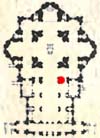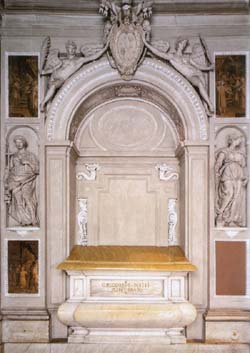 |
| Grottoes
Vatican City Colonnade Saints Floorplan #2 |
| Altars
Monuments The History |
| Related
Sites Gregory XIV |
|
"The ornamentation of a tomb, the show of mourning, and the funeral pomps, are consolations for the survivors, not benefits to the dead. For pious souls who, free from sins, have flown to the Lord, it matters little that their bodies have a sordid tomb, or none; even as the costliest tomb does nothing for the impious and those who are still bound in the bonds of sin." - Gregory XIV |
From: 'The Basilica of St. Peter's in the Vatican' by Franco Cosimo Panini
The funerary monument of Gregory XIV (Niccolo Sfondrati, born in Somma
Lombardo, Varese,in 1535, and pope from 1590 to 1591) is one of the less
elaborate in the Basilica and consists of a niche set into the wall with
a simple sarcophagus below, bearing the dedicatory inscription. Giacomo
della Porta was responsible for the design, while the sculpture is by
Prospero Bresciano. The pope's arms, supported by angels reclining in
the spandrels, crown the arch; two other coats of arms and two female
personifications are painted in grisaille in the intrados. At the sides
of the niche are statues of Religion (left) and Justice (right), and four
rectangular panels, three of which are decorated with monochrome frescoes.
From:
'Seminarian's Guide'
Gregory XIII was Pope for less than a year, in 1590 and 1591. He received
no statue, and is an unpopular Pope, for naming an inept family member
as Secretary of State who squandered the Papal treasury during a local
famine. Note unusual "XIIII" instead of "XIV." It is said to be a "recycled"
tombstone that had been rejected a year before for Gregory XIII's monument!
From: 'St. Peter's
Basilica - A Virtual Tour' by Our
Sunday Visitor
... the humble tomb of Gregory XIV. Built by Prospero da Brescia with
the two lateral statuettes of Faith and Knowledge, it was originally meant
for Pope Gregory XIII. However, after the transfer of his remains to the
above monument, the tomb was adapted with a stucco urn for Pope Gregory
XIV Sfondrati, who reigned for only 10 months, from 1590 to 1591.
From: 'Saint Peter's'
by James Lees-Milne
The lantern was put in place by Gregory XIV,who reigned for only ten months,
He had the grace to inscribe upon the rim of the eye under the lantern
the concise Latin phrase, which may be translated: "To the glory
of St. Peter and Pope Sixtus V in the fifth year of his pontificate, 1590
From: 'Lives of
the Popes'
The pontificate of Gregory XIV was one of the least popular and least
successful in history, marred as it was by the appointment of his incompetent
nephew as cardinal secretary of state and by plague, food shortages and
lawlessness in Rome.
Although only fifty-five years of age, he was physically weak and often in pain. The state of his health and his own insecurity about his lack of experience in the Curia led him to name his own twenty-nine-year-old nephew, Paolo Emilio Sfondrati, cardinal-secretary of state. Paolo, however, was more interested in his own and his family's well-being than in that of the Church. Resentment developed quickly among the other cardinals.
He also banned all gambling on papal elections, the length of a pontificate, or the creation of cardinals.
From: 'The Lives
and Times of the Popes' by The Chevalier Artaud De Montor
A great number of votes were united on Cardinal Gabriel Paleotto, but
he had not a sufficient number; two new cardinals arriving, thirty-six
votes were requisite. At length, on the 5th of December, 1590, at about
noon, the fifty-six electors elected, with open votes, Cardinal Sfondrati,
then aged fifty-five years. He thus on the instant found himself honored
with a charge which he had not expected or desired. At the moment he was
so astonished that, turning to the cardinals, who saluted him as Holy
Father, he said: "God forgive you! What have you done?"
However, he burst
into tears, and refused to walk, and his voice was choked with sobs. The
sedia gestatoria was brought in, and he was carried in spite of himself
into the Basilica of the Vatican, amidst the acclamations of the populace
who wished him a long reign.
Campana relates that, to relieve the sufferings of the patient, even pulverized
precious stones and gold were administered to him. Muratori, on that subject,
remarks: "This good pope, then, was surrounded either by stupid physicians
or culpable ministers." The pope soon sank under the violence of his sufferings,
and died on the 15th of October, 1591, at the age of fifty-six. He had
governed ten months and ten days. He was interred in the Vatican, towards
the middle of the Gregorian Chapel, near Gregory XIII, in a tomb almost
destitute of ornament.
------------------
The biographers mention as a curious personal trait of Gregory XIV a nervous
tendency to laughter which occasionally became irresistible, and which
manifested itself even at his coronation. He was succeeded by Innocent
IX after he died due to a large gallstone - reportedly 70 grams.


